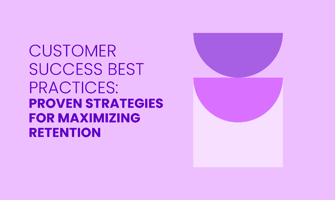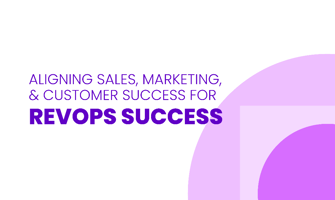Measuring how well a company meets customer needs is important for business growth.
The Role of CSM in Sales: Driving Revenue through Customer Success
Sales don’t end when a customer buys a product. That's where Customer Success Managers (CSMs) come in.
They help customers use products successfully. This keeps customers happy and loyal.
CSMs build relationships and teach customers. They also encourage renewals and suggest other products.
By doing this, they help drive more sales and keep revenue growing.
Understanding the role of CSMs shows how they boost a company’s success.
Defining the Customer Success Manager Role
A Customer Success Manager (CSM) ensures long-term customer satisfaction and retention. They guide customers from onboarding and throughout their entire journey. The goal is to enhance product use and overall customer well-being.
CSMs are different from Account Managers or Support Reps. They don't just handle immediate sales or fix issues. Instead, CSMs manage customer needs, find growth opportunities, and prevent churn.
The role requires working closely with sales and customer success teams. This helps create a smooth customer experience. Success is measured through metrics like retention rates, customer satisfaction, and revenue retention.
In SaaS companies, CSMs use tools and strategies like active listening and relationship marketing. These methods build trust and grow the customer base. Their efforts help customers become brand advocates and improve the brand's reputation.
How CSM Sales Aligns with Business Goals
Customer Success Managers help businesses meet financial goals by keeping customers happy and loyal.
They do this by:
Listening to customers.
Addressing customer concerns.
For example, CSMs onboard new clients, helping them understand the product. This helps with product adoption. CSMs build strong relationships, which helps keep customers and supports revenue retention. They also encourage upsells and cross-sells, which boosts revenue.
By onboarding customers and providing post-sales support, CSMs improve customer retention and loyalty. This personalized service and proactive support lead to higher customer satisfaction. This approach helps companies keep a stable customer base and create brand advocates who trust and promote the brand.
CSM activities align with KPIs like customer success metrics, retention rates, and customer health scores. Collaboration between sales and customer success teams reduces information silos and links sales processes with customer success performance. Monitoring KPIs allows CSMs to adapt strategies and provide value that meets the long-term needs of B2B SaaS companies. This enhances both employee satisfaction and overall business growth.
Key Responsibilities of a Customer Success Manager
Customer Onboarding
Customer onboarding involves several steps to ensure a smooth experience. This process impacts long-term customer retention.
First, the customer success manager works with sales professionals to align all teams. They share relevant information and use tools like HubSpot for better coordination.
The CSM welcomes new customers by providing an overview of their health and outlining the onboarding process. This helps set clear expectations. They also listen actively to understand long-term needs and address concerns right from the start.
During onboarding, the CSM guides customers through product adoption. They make sure customers are comfortable using the service, which enhances the overall experience. Best practices include timely follow-ups, educational resources, and consistent support from the customer success and support teams.
SaaS companies benefit by improving customer satisfaction and retention rates. This contributes to long-term revenue and creates brand advocates. A seamless onboarding process supports high customer satisfaction and improves performance indicators. This also backs up effective marketing and advertising campaigns.
A well-executed onboarding phase helps achieve customer success and fosters loyalty throughout the customer lifecycle.
Day-to-Day Tasks
A Customer Success Manager helps clients every day. They listen to understand needs, provide personalized support, and guide customers through onboarding.
The CSM works with the sales team to manage the customer journey. They ensure smooth transitions from sales to post-sales phases. By working with sales and the customer success team, the CSM addresses concerns and keeps customers satisfied.
The CSM prioritizes tasks based on customer needs. They focus on immediate concerns and long-term needs. They keep high retention rates by monitoring success metrics and performance indicators. They also look at the sales process and customer journeys to find opportunities for upselling or cross-selling.
Daily, the CSM uses tools like HubSpot and other software for managing customer success. They track performance, manage information, and improve employee satisfaction. They mix marketing and customer service strategies. This includes sending out a happy customers newsletter and updating brand perception through ads.
This routine keeps the customer base and revenue stable, supporting overall success.
Collaboration between Customer Success and Sales Teams
Customer Success Managers and Sales Teams work together to ensure customers have a great experience. They use active listening and shared goals to keep everything smooth. Frequent communication helps break down information barriers, so both teams can share insights.
For example, CSMs use advertising strategies to understand customer concerns. Sales teams can then address these concerns in their pitches. Manufacturers and SaaS companies benefit from this teamwork when they handle customer onboarding and support.
Effective communication involves regular meetings and real-time updates. Tools like Hubspot help maintain trust and track customer health. Newsletters keep everyone informed. Cross-functional training boosts employee satisfaction and helps teams understand each other's roles, improving collaboration.
For upsell and cross-sell opportunities:
The sales team and CSMs analyze customer data and journeys.
CSMs focus on post-sales phases to identify long-term needs.
Sales professionals aim for short-term goals.
Together, they use key performance indicators and success metrics to spot growth chances. This improves revenue retention and customer satisfaction. This joint effort ensures product adoption, builds brand perception, and creates happy customers and brand advocates.
Successful Strategies for Driving Revenue
To drive revenue, companies need a strategy that involves both sales and customer success teams.
Sales professionals look for new opportunities.
Customer Success Managers focus on satisfaction and retention.
CSMs identify long-term needs and reduce churn by giving personalized support during the customer lifecycle.
Active listening and ongoing support improve customer experience and boost retention rates.
This approach helps onboard new clients smoothly and ensures customer health after sales.
Businesses can also use data analytics to track customer success.
Key performance indicators and customer success metrics provide useful data.
This data helps create strategies for product adoption, revenue retention, and improving customer journeys.
Feedback from customers is important. It shows areas needing improvement and reveals chances for upselling and cross-selling.
Manufacturers, SaaS companies, and B2B businesses gain a lot from this alignment.
By working towards shared goals, these teams create a smooth customer experience. This turns customers into brand advocates.
Regular communication, like newsletters, keeps customers engaged and loyal.
Essential Skills for Customer Success Managers
Required Skills
A Customer Success Manager needs strong technical skills. This includes using customer relationship management (CRM) tools like HubSpot. They must understand the sales process and customer lifecycle to give useful insights.
Problem-solving and clear thinking are important for handling customer issues and improving their experience. They need to think quickly and come up with creative solutions for support and retention challenges.
Effective communication is crucial. CSMs must actively listen to understand customer needs and concerns. They should be good at both written and verbal communication to share information clearly with customers and different teams.
Collaboration skills are necessary. They have to work well with sales professionals, the sales team, and the customer success team. This ensures a smooth customer experience from onboarding to after-sales support.
In b2b SaaS companies, these skills lead to better customer onboarding, higher retention rates, and the creation of brand advocates. This results in improved overall customer success performance.
Value of Soft Skills
Soft skills are very important for a Customer Success Manager. They help build long-term customer relationships.
Active listening helps CSMs understand customer needs and concerns. This builds trust and creates happy customers.
Effective communication guides the sales team and the customer success team towards common goals. These skills ensure better customer onboarding and a smooth start in the customer lifecycle.
Soft skills also improve customer satisfaction by providing personalized support. This leads to higher revenue retention and better retention rates.
For manufacturers and B2B SaaS companies, this means fewer customer concerns and better customer success metrics.
Collaboration between sales and customer success professionals, enriched by soft skills, enhances the post-sales phase. This boosts customer health and builds brand advocates.
This impact extends to overall business goals. It influences customer success performance, employee satisfaction, and product adoption. In the end, it drives long-term needs and sustains a solid customer base.
Real Examples: Achieving Customer Success at HubSpot
![]()
HubSpot's customer success managers help clients by mixing sales, customer service, and support to meet long-term needs.
A good example is a B2B SaaS company aiming to improve customer retention. The customer success team listened carefully to spot problems during the sales and post-sales phases. They made customer onboarding easier, leading to better product use and a positive brand image.
They also created the "Happy Customers Newsletter" to share success stories and updates. This increased customer engagement.
Manufacturers using HubSpot saw better support and trust due to proactive management of the customer lifecycle. The partnership between sales professionals and customer success teams helped share information, making customer journeys smoother and increasing retention rates.
Teams tracked customer success metrics and key performance indicators. This ensured customer health and kept revenue high. As a result, customers became brand advocates, improving overall customer success.
Measuring the Impact of Customer Success on Revenue
Measuring how customer success affects revenue involves several metrics.
Important indicators include:
Customer retention rates
Revenue retention
Customer health scores
A high customer retention rate shows that the customer success team is effective. This leads to steady, long-term revenue growth.
In B2B SaaS companies, customer success managers help reduce churn and increase revenue retention. They can track their contributions through upsells and cross-sells during the post-sales phase. Monitoring customer onboarding efficiency is also important.
When customer success professionals listen actively and communicate well, it improves customer experiences and product adoption. This, in turn, strengthens the customer base.
Collaboration between sales, marketing, and customer support breaks down information silos. This improves employee satisfaction and brand perception.
Customer success metrics can demonstrate a positive impact on brand advocates and show ROI by analyzing the overall customer journey and sales cycle.
Tools like HubSpot track these metrics to ensure customer-first strategies build trust and loyalty.
Compensation Structures: Comparing CSM and Sales Professionals
The base salary and variable parts are different for Customer Success Managers and sales professionals.
Sales professionals usually have lower base salaries but higher variable components based on their sales performance.
On the other hand, CSMs generally have higher base salaries with smaller variable parts focused on customer success metrics such as:
Customer retention
Product adoption
Customer health
Their commission structures also differ. CSMs might earn bonuses for:
Customer onboarding success
Long-term customer satisfaction
Customer lifecycle management
Sales teams usually focus on new sales and revenue.
This difference affects job performance and motivation. Sales professionals are driven by immediate revenue goals. CSMs aim for sustained customer happiness and long-term value.
Collaboration between customer success and sales teams is also important, especially in B2B SaaS companies. Working together can break down information silos and ensure a smooth customer journey.
Effective teamwork between these teams can improve customer experiences and overall business success. Therefore, aligning their compensation packages with these shared goals is necessary.
Scaling Customer Success Operations
Scaling Customer Success operations requires investing in tools and technologies like customer relationship management systems.
These tools help streamline workflows. They can integrate with platforms like HubSpot to track customer health and key performance indicators.
The Customer Success team should work closely with the sales team. Cross-functional teams make this collaboration possible. Customer success managers can work alongside sales professionals. This way, they enhance the customer onboarding process and ensure smooth transitions after sales.
Standardizing processes like active listening, customer support, and customer onboarding helps maintain consistent customer experiences.
Methods such as relationship marketing, customer journey mapping, and regular customer lifecycle reviews can improve customer retention rates. These methods help meet the long-term needs of customers.
In B2B SaaS environments, customer success metrics drive employee satisfaction and revenue retention. Fostering trust and providing exceptional service can turn customers into brand advocates. This positively influences brand perception and customer success performance.
Success Metrics and KPIs for Customer Success Managers
Success metrics for a Customer Success Manager include:
Customer retention rates
Customer health scores
Net Promoter Scores (NPS)
These metrics link to goals like revenue retention and long-term customer satisfaction.
By focusing on customer retention, CSMs keep customers engaged through the sales cycle. This enhances overall customer success.
Metrics can be measured through:
Customer surveys
Support analytics
Regular NPS assessments
Tools like customer success software track these KPIs. They help reduce information gaps between the customer success team, sales professionals, and support teams.
Key actions that help include effective onboarding, active listening, and ongoing support. These lead to strong customer health scores and positive customer journeys.
Collaboration between sales and customer success teams meets customer needs. This turns customers into brand advocates, improving brand perception in competitive B2B SaaS industries.
Building Long-Term Kundenbeziehungen
Regular communication and feedback loops are important for long-term customer relationships.
Sales professionals and customer success managers should actively listen to understand customer needs and concerns.
Teams from sales, customer success, and customer support should work together. This ensures consistent messages and quick issue resolution.
For SaaS companies, customer onboarding is key for smooth transitions. It improves the customer experience and helps with product adoption.
The customer success team can monitor metrics like customer health and key performance indicators. This helps track customer satisfaction.
Building trust with customers through reliable service and support enhances relationship marketing. This enables brand advocates to spread positive views about the brand.
Collaboration helps prevent information silos. This ensures that manufacturers and B2B SaaS companies meet long-term needs. It also boosts customer retention and revenue.
By combining marketing and advertising efforts, customer success professionals can improve customer journeys. This includes promoting a happy customers newsletter and solidifying strong customer lifecycle management.
Future Trends in Customer Success and Sales
Artificial intelligence and automation will change the work of Customer Success Managers and Sales professionals. They will handle routine tasks, allowing professionals to build relationships and solve tough customer problems.
New important skills for Customer Success and Sales teams include:
Data analytics
Technical proficiency
Active listening
As customers seek more personalized experiences, teams need to focus on:
Customer journeys.
Customer health.
Thorough onboarding
Informations silos need to be broken for smooth collaboration and effective communication.
With changing customer expectations, teams must concentrate on:
Long-term needs
Customer onboarding
Personalized support
SaaS companies will benefit from:
Seamless integration of customer success metrics
Key performance indicators
This will help monitor customer satisfaction, increase product adoption, and turn satisfied customers into brand advocates.
Collaboration and active listening will help teams:
Maintain a collaborative atmosphere
Ensure customer loyalty
Drive revenue retention
FAQ
What is the role of a CSM in driving revenue through customer success?
A CSM drives revenue through customer success by increasing upsell and cross-sell opportunities, ensuring customer retention, and fostering long-term customer relationships. This can be achieved by identifying customer needs, providing tailored solutions, and delivering on promises.
How does a CSM help in increasing sales revenue?
A CSM helps in increasing sales revenue by identifying upsell and cross-sell opportunities, reducing customer churn through proactive support, and providing insights for product improvements. For example, by analyzing customer usage data, a CSM can recommend additional products or services to increase revenue.
What strategies do CSMs use to drive revenue through customer success?
CSMs use strategies such as upselling and cross-selling, identifying expansion opportunities, and ensuring customer satisfaction to drive revenue through customer success. For example, offering add-ons or premium features to existing customers can increase revenue.
What are the key responsibilities of a CSM in sales?
The key responsibilities of a CSM in sales include building relationships with customers, ensuring customer success, providing product education and training, and driving upsell opportunities. For example, a CSM should proactively address customer concerns, offer personalized solutions, and provide ongoing support.
How can a CSM contribute to the overall success of a sales team?
A CSM can contribute to the overall success of a sales team by providing valuable customer insights, facilitating cross-functional communication, and offering product training and updates. They can also help identify upsell opportunities and reduce churn by ensuring customer satisfaction and retention.




